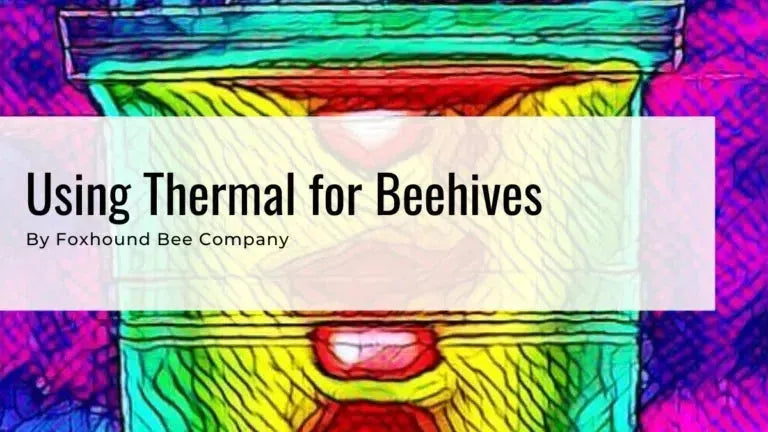

Thermal imaging cameras, also known as infrared cameras, are fascinating devices that capture images using infrared radiation instead of visible light. These cameras are designed to detect temperature differences in objects, making them incredibly useful in various conditions, such as low-light environments, through smoke, fog, or other obscurants.
Whether it’s for military, industrial, commercial, or residential purposes, thermal imaging cameras have a wide range of applications. They are commonly used for surveillance, predictive maintenance, and quality control, providing invaluable insights that are not possible with traditional cameras.
Thermal cameras detect hive heat, aiding non-invasive health monitoring, pest detection, and efficient bee removals. Ideal tools for precise hive management year-round.
Infrared cameras like FLIR simplify beekeeping, revealing brood clusters, hive strength, and feral colonies. Affordable phone-compatible options improve accuracy and convenience.
Thermal imaging offers insights into hive activity, winter survival, and pest issues. Maintain cameras well for consistent, reliable results in beekeeping applications.
Table of Contents
How Thermal Cameras Work
Thermal cameras operate by detecting infrared radiation emitted by objects. Unlike visible light, infrared radiation is not visible to the human eye, but thermal cameras can convert this radiation into a visual image.
The sensors installed in these cameras, which can be based on technologies like bolometers or infrared photodetectors, capture the infrared radiation and translate it into temperature values.
This process allows the camera to produce a thermal image of the scene being observed. The camera software then processes these signals, enabling non-contact temperature measurements, temperature analysis, and even alarm triggering when certain temperature thresholds are met.

Benefits of Using Thermal Cameras in Beekeeping
Thermal cameras offer numerous benefits for beekeeping by allowing beekeepers to detect warm objects, such as beehives, against a cooler background. This capability is particularly useful for monitoring the health and activity of bees without disturbing them.
By detecting temperature differences within the hive, thermal cameras can help identify potential problems, such as disease or pests, early on. Additionally, during the winter months , thermal cameras can monitor the hive’s temperature, ensuring that the bees are staying warm enough to survive. This non-invasive method of monitoring can significantly improve hive management and overall bee health.
Thermal Imaging Cameras Beehives And Bee Removals
A thermal camera or infrared camera made by FLIR or SEEK is indispensable when it comes to locating bees inside a wall or estimating a bee hive's strength with minimal interference. These cameras often utilize infrared imaging sensor arrays to detect the heat emitted by bees, allowing for precise monitoring of hive conditions.
They do an excellent job detecting the changes in surface temperature so that what is behind the surface is revealed. This is exactly what you need as a beekeeper to locate a feral colony inside a building or simply just check the strength and location of your winter clusters in your normal hives.

FLIR= Forward Looking Infrared Cameras
If you remove bees from buildings or are interested in starting to do so, a FLIR system is worth the purchase. It can save a lot of time, increase your confidence, help keep costs low, and increase the homeowner's confidence in you. FLIR systems are known for their ability to capture real-time thermal images, making them highly effective for locating beehives.
Using forward looking infrared cameras will quickly identify where an established hive is, and most importantly, where it isn’t. Often, wild hives are built right up to the stud or rafter in a home and knowing where the hive stops can help you make cuts into the drywall or flooring in the right spot.




Thermal Camera Hardware With Infrared Imaging Sensor Arrays For Iphone And Android
The hardware required is just a phone (which you probably have) and a thermal camera that attaches to the port on the phone. These thermal cameras detect infrared light emitted by objects, allowing users to see temperature differences on their phone screens. It doesn’t actually use the phones camera to work, it just uses the screen to see what the thermal camera is seeing.
If you have an Android phone with a USB-C charging port on the bottom, this is the camera you need. To check to see if your phone is compatible, click here.
If you have an iPhone, this is the camera you need. To check to see if your phone is compatible, click here.
The cameras are very important, but we would recommend also getting a small extension cable to make it easier to handle. Sometimes you will want to point the camera in a direction that is in a place where you phone can’t go. This is the extensions for the android and the iPhone .
Safety Precautions and Maintenance
When using thermal cameras, it’s crucial to follow safety precautions to avoid injury or damage. For instance, thermal cameras should not be used in explosive environments, and users should avoid touching the camera’s lens or sensor to prevent damage. Regular maintenance is also essential to ensure the camera continues to function properly.
This includes cleaning the lens and sensor, updating the software, and performing routine checks on the camera’s electrical components. By taking these steps, you can ensure your thermal camera remains in good working condition and continues to provide accurate and reliable results.
Conclusion
Thermal imaging cameras are powerful tools with a wide range of applications, from military and industrial to commercial and residential uses. By detecting infrared radiation emitted by objects, these cameras can produce images in low-light environments, through smoke, fog, or other obscurants.
Their ability to detect warm objects and temperature differences makes them ideal for surveillance, predictive maintenance, and quality control. In beekeeping, thermal cameras offer a non-invasive way to monitor hive health and activity, ensuring the well-being of the bees. By following safety precautions and performing regular maintenance, you can ensure your thermal camera continues to function properly and provide valuable insights for years to come.





